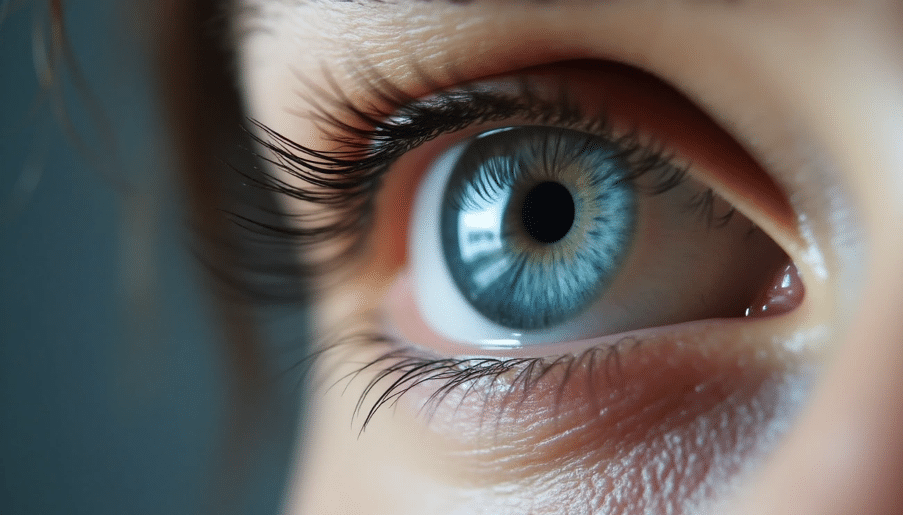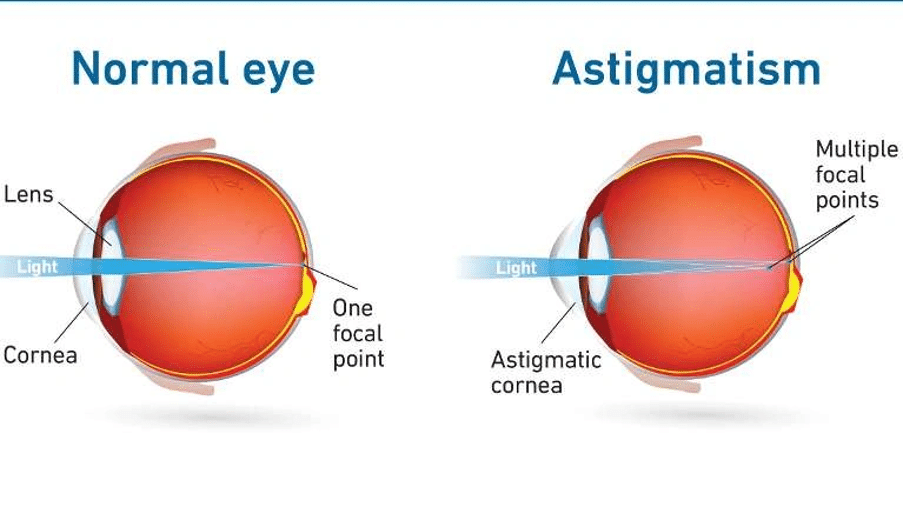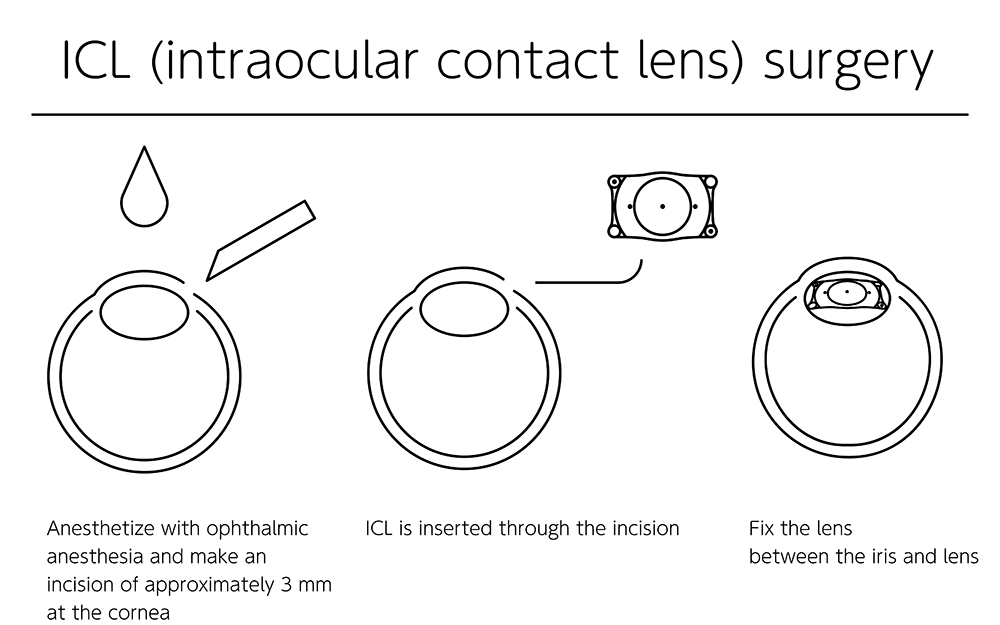Astigmatism affects about 1 in 3 people worldwide. The UK shows even higher numbers, with nearly 50% of people wearing glasses having some form of astigmatism. People with astigmatism have corneas or lenses shaped irregularly, unlike the round corneas of normal eyes.
Most people experience blurred or distorted vision, eye strain, and headaches as common symptoms. Eye specialists often find astigmatism among other vision problems like myopia (shortsightedness) and hyperopia (longsightedness). The condition’s origins vary – some people are born with it while others develop it over time. Children need early detection because astigmatism can substantially affect their academic performance and achievements.
This piece covers essential information about this treatable eye condition. You’ll learn about its symptoms, why it happens, and the latest treatment options. We’ll also guide you to know the right time to visit an eye specialist in London to receive personalised care and proper diagnosis.

What is Astigmatism in the Eye?
Understanding astigmatism requires knowledge of normal vision function and changes that occur in this common eye condition.
How the eye normally focuses light
Light enters through the cornea—the clear, dome-shaped front surface in a healthy eye. The cornea’s main goal is to bend (refract) incoming light rays. Light passes through the pupil while the iris controls the amount of light entering. The lens works with the cornea to focus rays onto the retina at the back of the eye. Both the cornea and lens have evenly curved surfaces (like a basketball) in normal vision. This ensures all light rays join at a single point on the retina. Your brain interprets clear, detailed images without distortion with this perfect focus.
What happens in astigmatism
The cornea or lens has an irregular shape in an eye with astigmatism—more like a rugby ball or football than a basketball. This irregularity prevents the eye from focusing light uniformly. Light rays focus at multiple points instead of joining at one point on the retina. Eye specialists call these “focal lines” rather than a single focal point. Images appear blurred or distorted whatever the distance. Objects might look elongated, duplicated, or have shadowy outlines.
There are two main types:
- Corneal astigmatism: Your cornea has an oval or irregular shape instead of being perfectly round
- Lenticular astigmatism: The lens inside your eye has an uneven curvature
Astigmatism meaning in simple terms
Astigmatism means your eye’s focusing surface looks more like an egg than a sphere. Picture this—a perfectly round eyeball focuses light evenly, just like a properly adjusted camera lens. An eye with astigmatism works like a camera with a warped lens that creates stretched or blurry images in certain directions.
People are usually born with astigmatism, though it can develop after eye injury, disease, or surgery. This condition occurs among other vision problems like shortsightedness or longsightedness. Keep in mind that in stark comparison to some myths, reading in poor light, sitting too close to screens, or squinting doesn’t cause or worsen astigmatism.

Common Symptoms of Astigmatism
Early detection of astigmatism symptoms helps prevent eye strain and ensures you get the right treatment. Astigmatism affects approximately one in three people, so understanding its signs is vital.
Blurred or distorted vision
Blurred or distorted vision stands out as the main symptom of astigmatism that affects both near and distant objects. Your vision becomes unclear at all distances, unlike other vision problems that might only affect close-up or far-away sight. You might also see straight lines appearing wavy or objects looking stretched or compressed in certain directions.
Eye strain and headaches
Your eyes work harder to focus properly, which makes eye strain almost unavoidable. This constant effort often brings on headaches, especially after you spend time reading, working on computers, or doing other tasks that strain your eyes. Research shows a link between astigmatism and higher rates of migraine headaches.
Blurry vision, eye strain, or headaches could be signs of astigmatism. At Precision Vision London, our specialists offer in-depth diagnostics and advanced treatments.
Difficulty seeing at night
Night vision becomes more challenging with astigmatism. Your pupils get larger at night to let in more light, which makes focusing problems worse. You might notice:
- Halos or ‘comet-like’ streaks around lights
- More glare from headlights and street lamps
- Lights that look blurry or fuzzy with streaks
Squinting or double vision
People who have astigmatism often squint to see better temporarily. Some cases, especially those with severe or irregular astigmatism, might cause you to see double or multiple images of single objects.
Signs of astigmatism in children
Children might not tell you about their vision problems, so parents should look for these signs:
- Regular eye rubbing or squinting
- Sitting too close to screens or books
- Head tilting to one side while focusing
- Sensitivity to light
- Problems with reading or seeing information on boards at school
Finding astigmatism early in children matters because it can change how their vision develops and how well they learn.
What Causes Astigmatism?
Learning why astigmatism happens can help you manage this common eye condition better. Research shows astigmatism affects up to 36.2% of adults over 20 in the United States. Scientists haven’t fully understood the exact mechanisms that cause it yet.
Genetic and hereditary factors
Your genes play the most important role in developing astigmatism. Research reveals astigmatism has a broad sense heritability of about 60%, that indicates strong genetic links. Yes, it is true that your risk of developing astigmatism increases when your parents have it. Research shows your chances double if you have first-degree relatives with this condition. Your biological parents can pass down astigmatism to you. Scientists have linked the VAX2 gene, an eye-specific homeobox gene involved in ventral eye development, to astigmatism risk.
Eye injuries or surgery
Your eyes can develop astigmatism from external factors too. Corneal injuries can lead to irregular astigmatism. Eye surgery complications, including those from cataract procedures, might change your cornea’s smooth, regular shape. These changes can trigger or worsen astigmatism by affecting the normal corneal surface.
Keratoconus and other corneal conditions
Keratoconus progressively thins your cornea and makes it bulge outward like a cone. This creates severe irregular astigmatism that often gets worse as your corneal structure weakens. Young people usually develop keratoconus during their teens or early twenties, and without treatment, it can severely impact their vision.
Can screen time or poor lighting cause it?
Reading in poor light or sitting too close to TV screens doesn’t cause or worsen astigmatism. In stark comparison to this, a newer study suggests excessive screen time might link to astigmatism, especially when you have children. Research found each extra hour of daily screen time increased astigmatism levels. Scientists think this happens because looking down at screens puts more pressure from your eyelids onto the cornea, possibly changing its shape.
How Astigmatism is Diagnosed and Treated
Qualified eye care professionals use specialised testing to diagnose astigmatism accurately. The right diagnosis helps identify proper treatment options that correct vision and enhance quality of life.
Eye tests used to detect astigmatism
Your eye specialist will perform a detailed eye examination that has specific tests to detect what is astigmatism in your eyes. These tests include:
- Visual acuity test: Measures how clearly you can see at various distances using eye charts
- Refraction test: Determines how light bends as it enters your eye
- Keratometry: Measures your cornea’s curvature to assess astigmatism levels
- Slit lamp examination: Uses a special microscope with bright light to examine your eye’s different layers
Prescription glasses and toric lenses
Prescription glasses are the first treatment option after diagnosis. Astigmatism glasses have special cylindrical lenses that balance the irregular corneal shape and help focus light on the retina. These lenses work against uneven curvatures in your cornea or lens. Toric lenses provide a great alternative for contact lens users. These special contacts stay oriented on the eye to deliver consistent vision correction.
Laser eye surgery options (LASIK, PRK)
Laser eye surgery provides a lasting solution to correct astigmatism. LASIK (Laser-Assisted In Situ Keratomileusis) creates a thin corneal flap, reshapes it with an excimer laser, and repositions it. PRK (Photorefractive Keratectomy) works similarly but removes the epithelium completely so it grows back naturally.
Precision Vision London specialists provide detailed diagnostics and advanced treatments from LASIK to ICL surgery. You can book a consultation to receive expert guidance and clear answers.
ICL surgery for high prescriptions
ICL (Implantable Collamer Lens) surgery works best for patients with high prescriptions who might not qualify for laser procedures. This method uses soft, flexible lenses to correct prescriptions up to -18.00D for short-sightedness and up to +/- 4.50D of astigmatism. These lenses rest between the iris and natural lens to provide excellent vision.

When treatment is necessary
You need treatment if astigmatism affects your daily activities or causes blurred vision, eye strain, or headaches. Early correction is vital for children since untreated astigmatism can lead to lazy eye. Prescription eyewear manages mild cases effectively, while moderate to severe cases might need surgical intervention.
Conclusion
Millions of people in the UK have astigmatism, but many don’t know they have this common eye condition. Blurred vision, eye strain, headaches, or trouble seeing at night could be signs you need treatment. Your genes are the most important factor in developing astigmatism. Eye injuries, keratoconus, and maybe too much screen time can make it worse.
Modern eye care gives you several ways to treat astigmatism effectively. Prescription glasses or special contact lenses work well for mild cases. LASIK, PRK, and ICL surgery are options that give more lasting results. Your eye doctor will help you choose the right treatment based on your condition, prescription, and lifestyle.
Precision Vision London’s specialists use innovative technology to measure your cornea’s shape and understand your astigmatism type. This full picture will give a treatment plan just for you, based on your eye’s structure and what you need to see clearly. Our expert team explains all your options and helps you make smart choices about your eye care experience.
Finding astigmatism early is especially important when you have children. Without treatment, it can affect how they see and do in school. Your family should get regular eye check-ups, whatever your current vision might be.
Astigmatism doesn’t have to hold you back. The right diagnosis and treatment help you see clearly at any distance. If you notice any symptoms mentioned in this piece, booking time with Precision Vision London is your first step toward better vision. We use innovative treatments designed just for your needs to help you see clearly again.
Key Takeaways
Understanding astigmatism empowers you to recognise symptoms early and seek appropriate treatment for clearer, more comfortable vision.
- Astigmatism affects 1 in 3 people globally, causing blurred vision at all distances due to irregular cornea or lens shape.
- Common symptoms include eye strain, headaches, difficulty with night vision, and seeing halos around lights.
- The condition is primarily hereditary (60% genetic component) but can also result from eye injuries or surgery.
- Treatment options range from prescription glasses and toric lenses to advanced laser surgery (LASIK, PRK, ICL)
- Early diagnosis is crucial for children as untreated astigmatism can impact visual development and academic performance
Regular eye examinations remain essential for detecting astigmatism, particularly since many people are unaware they have this treatable condition. With proper diagnosis and modern treatment options, astigmatism needn’t limit your daily activities or quality of life.
FAQs
Q1. What are the main symptoms of astigmatism? The primary symptoms include blurred or distorted vision at all distances, eye strain, headaches, difficulty seeing at night, and seeing halos around lights. Some people may also experience squinting or double vision.
Q2. Can astigmatism be corrected? Yes, astigmatism can be corrected. Treatment options include prescription glasses, toric contact lenses, and laser eye surgery procedures such as LASIK or PRK. For those with high prescriptions, ICL surgery may be recommended.
Q3. Is astigmatism hereditary? Astigmatism does have a strong genetic component, with a broad sense heritability of about 60%. If your parents have astigmatism, you’re more likely to develop it. However, it can also be caused by eye injuries, certain corneal conditions, or develop after eye surgery.
Q4. How is astigmatism diagnosed? Astigmatism is diagnosed through comprehensive eye examinations. These typically include visual acuity tests, refraction tests, keratometry to measure corneal curvature, and slit lamp examinations. These tests help determine the presence and severity of astigmatism.
Q5. Can children have astigmatism? Yes, children can have astigmatism. It’s often present from birth and can affect visual development if left untreated. Signs in children may include frequent eye rubbing, sitting close to screens, tilting the head while focusing, and difficulty with school tasks involving reading or recognising information on boards.
Authors & Reviewer
-
 Olivia: Author
Olivia: AuthorHi, I'm Olivia, a passionate writer specialising in eye care, vision health, and the latest advancements in optometry. I strive to craft informative and engaging articles that help readers make informed decisions about their eye health. With a keen eye for detail and a commitment to delivering accurate, research-backed content, I aim to educate and inspire through every piece I write.
-
 Dr. CT Pillai: Reviewer
Dr. CT Pillai: ReviewerDr. CT Pillai is a globally recognised ophthalmologist with over 30 years of experience, specialising in refractive surgery and general ophthalmology. Renowned for performing over 50,000 successful laser procedures.

